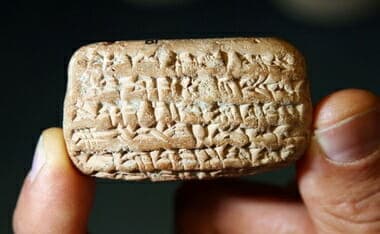(See the Poached Egg a year back)
Working at the British Museum, Assyriologist Michael Jursa has made a breakthrough discovery whilst examining a small clay tablet with a Babylonian cuneiform inscription. The document is dated to the 10th year of Nebuchadnezzar II (595 BC). It names a Babylonian officer, Nebo-Sarsekim, who according to chapter 39 of the Book of Jeremiah was present at the siege of Jerusalem in 587 BC with Nebuchadnezzar himself. The tablet thus confirms the historical existence of the Biblical figure. Evidence from non-Biblical sources for individuals named in the Bible other than kings is incredibly rare
Nebo-Sarsekim is described in the book of Jeremiah as ‘chief eunuch’ (as the title is now translated, rather than ‘chief officer’). The Babylonian tablet proves that his name was really pronounced as Nabu-sharrussu-ukin, and gives the same title, ‘chief eunuch,’ in cuneiform script, thereby confirming the accuracy of the Biblical account.
The discovery highlights the importance of the study of cuneiform. The British Museum’s collection contains well over one hundred thousand inscribed tablets which are examined by international scholars on a daily basis. Reading and piecing together fragments is painstaking and slow work, but cuneiform tablets are our only chance of obtaining knowledge of this fateful period of human history. Other discoveries made whilst examining tablets include an Assyrian version of the Old Testament flood story, observations of Halley’s Comet and even rules for the world’s oldest board game.
Dr Jursa, Associate Professor of the University of Vienna, has been studying tablets at the British Museum since 1991. He says of this discovery:
“Reading Babylonian tablets is often laborious, but also very satisfying: there is so much new information yet to be discovered. But finding something like this tablet, where we see a person mentioned in the Bible making an everyday payment to the temple in Babylon and quoting the exact date is quite extraordinary.”
Irving Finkel, Assistant Keeper in the Department of the Middle East at the British Museum, commented: “Cuneiform tablets might all look the same, but sometimes they contain treasure. Here a mundane commercial transaction takes its place as a primary witness to one of the turning points in Old Testament history. This is a tablet that deserves to be famous.’
h/t to the members at The Christian Apologetics Alliance andQuite Time Thoughts
